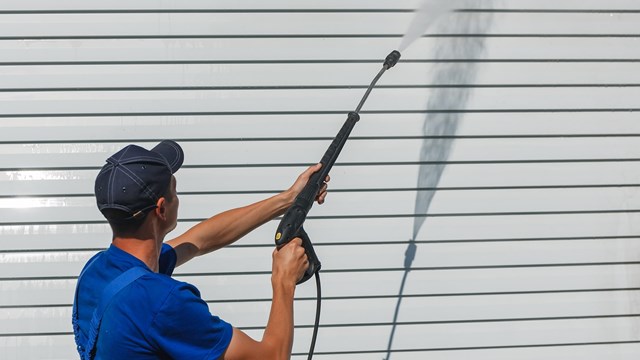
There was a time when most large residential developments relied on glaring floodlights to brighten parking lots, front porches and entryways. Today, there is more to exterior lighting than just chasing shadows away and discouraging crime. Lighting is now a deliberately thought-out part of residential community design, with a lasting impact on value.
Lighting Plan
It is highly recommended that before your community decides to tackle exterior lighting, you consult with a professional that will be able to devise a plan that is most efficient and in line with your financial situation. In many instances, it may just take a simple replacement.
Rick Norwood, president of Outdoor Lighting Perspectives in Romeoville, says that his team recently worked on a community where instead of adding more fixtures, they replaced high pressure sodium bulbs with induction bulbs, which cast more light and are more energy efficient than traditional, and even LED lights, he says.
“In a lot of instances you don't have to buy a new fixture, you can retrofit the existing post lights or parking lot structures, to keep the fixtures but replace the bulb,” he says.
Ronique Gibson, LEED AP, and an associate architect, who contributes to Freshome and Stagetecture web blogs dedicated to design and architecture, advises HOA boards to “determine how many lights you will need in advance before you start installing. Homeowners often don’t take into account adjacent street lighting or neighboring houses, and other external factors that may cast light onto their property as well. Walk around your home at dusk, right before the sun will set. Take note of what areas need additional lighting.”
The plan should also include an assessment of the possible cost, says Eric Strandberg, a senior lighting specialist and a licensed contractor with the Northwest Energy Efficiency Alliance’s Lighting Design Lab. “Good exterior entry lighting is based on many decisions, not just on first cost. Will there be high long term maintenance costs? For example, a 300-watt halogen flood light may cost $10 to buy while a 22-watt CFL costs $30, making the halogen appear the better buy. But if the fixtures are on 10 hours a day, they will have an annual operating cost of: $6.92 for the CFL and $63.70 for the halogen (at $.05/kWh). Plus, the CFL lasts 10,000 hours while the halogen lasts only 2,500 hours.”
Lighting the Way
For landscape artists and lighting designers, exterior lighting generally consists of four major categories: safety and walkway lighting; ambient lighting; feature lighting; and security and floodlights.
As the name suggests, safety and walkway lighting are used to mark a building’s entry points and safely lighting the surrounding property. This lighting is also used for any signs or building numbers throughout a complex or community. Strandberg says when it comes to exterior lighting, there are two main rules to design by: “'Less is more,’ and ‘Many are better than one.’”
When these two seemingly contradictory principles are applied to entryway lighting, they result in more inviting, calming and uniform light levels. “Use multiple low light-level fixtures instead of one very bright fixture,” Strandberg advises. “If you use just one fixture, the area nearest it is too bright and the areas further away are too dim. Using multiple fixtures lets you put the light in the key areas of interest—near signs, by doorways and stairs, thus more evenly distributing the light.”
But exterior lighting doesn’t have to be purely utilitarian. Even the smallest touch of “lightscaping” can add flare to functionality. According to the Freshome website, “Lighting fixtures can make your front entry look amazing at night, as well as keep your guests safe. Exterior lighting can range from single pendant light above the front door, or wall sconces that flank the sides of the door.” Additionally, “Wall sconces can provide washes of light against the exterior walls of your home to create ambiance in the evening hours. Directional sconces pointing upwards or downwards can focus on architectural elements of your home, and draw attention to exterior niches and plantings around your home.”
Bulb Blunders
According to Walter Salik, a lighting consultant at Fox Lighting Galleries in Chicago, homeowners frequently choose outdoor fixtures that aren't the best fit for their intended use or desired effect. “Too small fixtures are a common mistake. People are afraid to use a larger fixture—that is probably the biggest mistake. They are so used to seeing small fixtures on large buildings.”
Not planning for the long term in terms of energy efficiency is another mistake often made by boards, says Norwood. He says that outdated or damaged lights are replaced with the same traditional bulbs, which use more energy and burn out faster, thus replacement costs will add up.
“Boards don't make the initial investment. The norm for a break-even is four to five years for LEDs and other energy saving solutions with maintenance and energy. So it may take some time but in the long term it is well worth the savings in energy and utility bills,” he says.
In accordance with Strandberg’s “less is more” advice, experts caution against “over-lamping.” Don't put in the maximum wattage bulb just because you can. Many fixtures are rated for 60-watt bulbs but three 60-watt bulbs are much too bright for an outdoor fixture in general usage. Experts suggest putting in only 25 watts or 40’s maximum.
Strandberg warns of the risks of glare caused either by direct view of an unshielded light source or by too much contrast if the rest of the exterior is relatively dark. “Extra light does not always mean we can see any better,” says Strandberg. “The eye can adapt to very low light levels and very high light levels but it only adapts to one light level at a time. When someone leaves an excessively-lit building, it takes the eye longer to adapt from a bright entry to the darker walkways outside, making it difficult to see.” He also notes that a really bright entryway makes the walkway approaching it appear dark, which could be a problem.
Setting the Mood
Another common mistake made by HOAs is not putting in adequate landscape lighting or any landscape lighting at all. “Homeowners associations spend tens of thousands of dollars on beautiful landscaping and only enjoy it during the daylight hours,” he says. “Nighttime happens to be the most dramatic time to see your landscaping.”
The good news is that you can add landscape lighting to any kind of landscaping design to set a mood, create interest, or highlight key features of your HOA’s landscape design, such as statues or structures. Properly utilized landscape lighting can also improve safety on your HOA's grounds.
There are typically two types of landscape lights: solar powered and electric. Solar powered landscape lights have a solar cell that takes the energy from the sun and stores it in rechargeable batteries. According to landscaping and garden design writer Andrew Caxton, “Solar landscape lights are not very expensive but they may not shine very long or brightly, depending on their batteries. They are easy to install however and easy to maintain.”
When lights are powered by an electrical source, the wires are run underground and are powered the community’s electrical system. “This type of landscape light is best used for larger areas,” advises Caxton. He also points out that electrical lighting provides more flexibility. “If you choose electric lights, then you can change out the light bulbs to go with the seasons—red and green for Christmas, orange for the fall and Halloween, and pastel colors for the spring and Easter. This is a simple way to integrate your lights into your decorating scheme.”
With regards to deck, pool or patio lighting, home and garden specialist Gary Jones advises to pay particular attention to where people will be seated. “The lighting source should be positioned so that people are not looking directly into the light and to avoid glare.”
To extend nighttime use of your garden or patio area Jones suggests, “You may wish to consider heat lamps that radiate heat onto a person’s body without heating the surrounding atmosphere. These can be positioned on walls around the central entertainment area, or under a patio canopy.”
In the Spotlight
Jones adds that downlighting is recommended as an effective and affordable method of security lighting “to illuminate large areas position bright spotlights near the roof of your home.” Additionally, “use of a timer switch or infrared security sensor in conjunction with your garden lighting can act as an effective security device.” Whether you are lighting your exterior for functionality or ambiance, Jones recommends that light sources themselves should always be concealed. “Ideally, you should be unable to see where the light originates from.”
Green Lighting
If your board or HOA is feeling ambitious and considering a full scale, environmentally friendly “green” upgrade or retrofit, you may need a professional's guidance and assistance to weed through the thicket of conflicting information about products and methods.
However, Seattle’s Learning Design Lab stresses that not all LEDs are created equal. “Currently, relatively low overall light output, poor color rendering and questions about advertised service life may indicate that LEDs, while very useful in many applications, are not yet ready for 'prime time' in some architectural applications. In the end when it comes to 'going green' it is still best to go to a qualified expert.”
Induction bulbs are another energy efficient option that Norwood prefers to use when installing or retrofitting lights. Induction differs from LED and conventional bulbs in that power is transferred to the interior of the lamp by means of a strong magnetic field generated by inductors which are external to the lamp envelope—there are no electrodes going through the glass walls of the lamp.
Landscaping and ground maintenance is often one of the largest expenses facing an HOA community yet the results go unnoticed 50 percent of the time. When lightscapes are created with well-placed lighting, a property is showcased and the results are almost magic. A properly illuminated landscape increases curb appeal 24/7 and adds real and perceived value to the property.
J.M. Wilson is a freelance writer and a frequent contributor to The Chicagoland Cooperator. Editorial Assistant Maggie Puniewska contributed to this article.






Leave a Comment